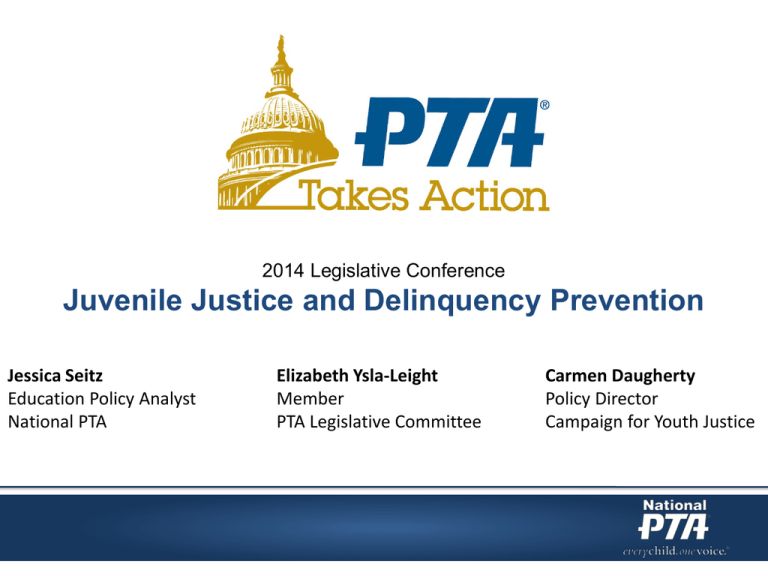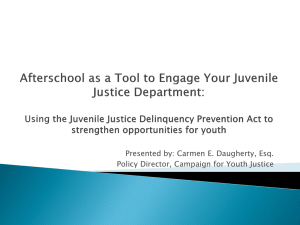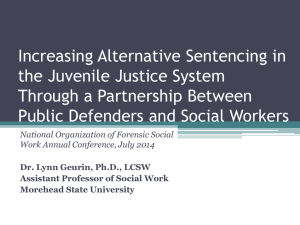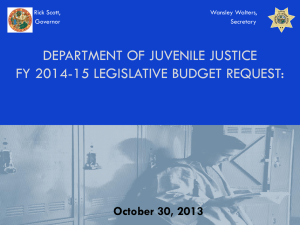Juvenile Justice Updates
advertisement

2014 Legislative Conference Juvenile Justice and Delinquency Prevention Jessica Seitz Education Policy Analyst National PTA Elizabeth Ysla-Leight Member PTA Legislative Committee Carmen Daugherty Policy Director Campaign for Youth Justice Agenda 1. PTA & Juvenile Justice a. History and Position Statement 2. Juvenile Justice and Delinquency Prevention Act (JJDPA) a. Overview b. Core Protections c. PTA Recommendations to Congress 3. Juvenile Justice Updates a. On the Hill b. In the Courts c. In the States 4. Q&A PTA & Juvenile Justice: History • 1899: PTA convention delegates pass first juvenile justice-related resolution supporting the extension of juvenile courts and probation systems to prevent children from being incarcerated with adults • 1903: PTA establishes Committee on Juvenile Protection • 1950s-1960s: PTA mobilizes members to advocate for policies that place less emphasis on incarceration, calling instead for increased supportive services and protection of all children PTA’s Position Statement on Juvenile Justice • • • • • • • Promote initiatives to address racial, ethnic, and socioeconomic inequities in the juvenile justice system. Encourage collaboration between law enforcement, the judicial system, and child welfare agencies. Promote alternative dispute resolution techniques that provide a range of possible sanctions. Prohibit youth who are charged with a serious crime from being tried in the adult court system unless there has been an opportunity for a judicial hearing and appeal. Prohibit the incarceration of youth in adult facilities. Assist youth leaving the juvenile justice system and prevent their return. Support research and data collection regarding youth offenses. Juvenile Justice and Delinquency Prevention Act (JJDPA): Overview and Key Dates • 1974: JJDPA enacted • 2002: Most recent reauthorization of the JJDPA • 2007: JJDPA becomes eligible for reauthorization • 2009: Most recent introduction of JJDPA reauthorization (passed Senate committee) Juvenile Justice and Delinquency Prevention JJDPA Core Protections 1. Deinstitutionalization of Status Offenders (DSO) (1974) 2. Sight and Sound Separation (1974) 3. Jail Removal (1980) 4. Disproportionate Minority Contact (1992) JJDPA Core Protections Deinstitutionalization of Status Offenders (DSO) • • Definition: Requires that youth with status offenses not be placed in secure detention or confinement. Limitations: Valid Court Order (VCO) exception PTA Recommendations for DSO Improvement: 1. Eliminate the VCO exception to ensure that youth who commit status offenses are kept out of facilities. 2. Update the JJDPA to decrease overreliance on youth incarceration and out-of-home-placement by promoting familyfocused and school-based interventions for truant youth. JJDPA Core Protections Removal of Juveniles from Adult Jails and Lockups (“Jail Removal”) • Definition: Prohibits, under most circumstances, the detention of juveniles in adult jails or lockups. • Limitations: • Does not protect juveniles that are waived to adult court • Juveniles can be held for up to six hours for processing and for 24 hours (plus weekends and holidays) in rural areas JJDPA Core Protections Juvenile Sight and Sound Separation • Definition: Requires that accused and adjudicated delinquents, status offenders, and non-offending juveniles be kept out of the “sight and sound” of adult inmates. • Limitations: Does not apply to youth prosecuted in the adult criminal justice system. PTA Recommendations for Juvenile Sight and Sound Separation & Jail Removal Improvement 1. Codify the definition of “adult inmate” in the JJDPA to allow states to place children convicted in adult court into juvenile facilities. 2. Extend the Jail Removal and Sight and Sound Separation core protection of the JJDPA to all children under 18 years of age who are held pretrial, regardless of whether they are charged in juvenile or adult court. JJDPA Core Protections Disproportionate Minority Contact (DMC) • Definition: Requires states to take measures to reduce racial/ethnic disparities in the juvenile justice system. PTA Recommendations for DMC Improvement: Strengthen the DMC core protection by requiring states to take concrete steps to reduce racial and ethnic disparities in the juvenile justice system Other PTA Juvenile Justice Recommendations Create a National Technical Assistance Center on Family Engagement to provide support to state and local justice and child-serving agencies interested in starting or growing family engagement programs in the juvenile justice system. Reauthorize the Second Chance Act–an important source of funding for youth reentry programs across the nation. PTA Takes Action JUVENILE JUSTICE UPDATES On the Hill, In the Courts, In the States On the Hill • JJDPA Reauthorization • Second Chance Act Reauthorization • Prohibiting Detention of Youth Status Offenders Act In the Courts: Miller v. Alabama (2012) • Ruling: Mandatory life without the possibility of parole unconstitutional when applied to those under the age of 18 at the time of their crimes. • PTA Takes Action: How PTAs can be involved at the court-level. In the States: Great Progress! Removing Youth from the Adult Criminal Justice System Key issues in Juvenile Justice: Overreliance on incarceration On any given day, over 42,000 youth are held in in juvenile detention facilities, corrections facilities, group homes or shelters. Financial implications: • The cost to incarcerate an individual for 9 months is between $66,000 and $88,000 • $7.1 million dollars are spent every day to lock up youth in adult facilities • Alternatives to incarcerating youth not only reduce crime, but save money. Every $1 spent on evidence-based programs can yield up to $13 in cost savings. Removing Youth from the Adult Criminal Justice System: Key Trends Trend 1: Removing youth from adult jails and prisons Trend 2: Changing the age of juvenile court jurisdiction Trend 3: Changing transfer laws to keep more youth in juvenile court Trend 4: Modifying youth sentencing laws Eleven limited the state’s authority to house youth in adult jails and prisons: Colorado Idaho Indiana Maine Nevada Ohio Hawaii Virginia Pennsylvania Texas Oregon Four expanded juvenile court jurisdiction so that older youth who previously would be automatically tried as adults are not prosecuted in adult criminal court Connecticut Illinois Mississippi Massachusetts Eleven changed transfer laws to make it more likely that youth will stay in the juvenile justice system: Arizona Colorado Connecticut Delaware Illinois Maryland Nevada Ohio Utah Virginia Washington Eight changed their mandatory minimum sentencing laws, allowed for post-sentence review for youth facing juvenile life without parole, or passed other sentencing reforms California Colorado Georgia Indiana Missouri Ohio Texas Washington Questions? Jessica Seitz Education Policy Analyst National PTA jseitz@pta.org Office: (703) 518-1249 Cell: (405) 664-3093









